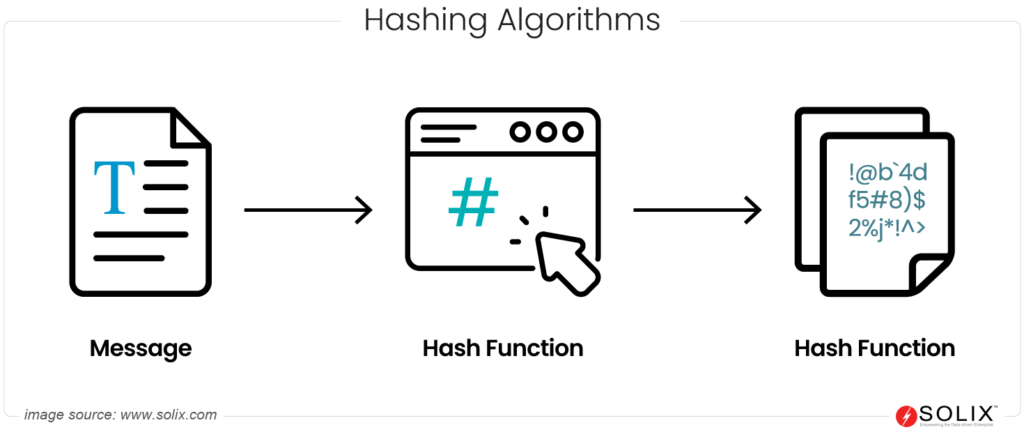Hashing
What is Hashing?
Hashing is a data masking technique that transforms input data into fixed-length strings of characters, typically a hash value or checksum. It generates a unique output for each input, making it computationally infeasible to reverse the process and obtain the original data. This cryptographic technique is widely used in data security and integral to various data masking strategies.

Benefits of Hashing
Hashing is a versatile cryptographic process integral to various data security practices, including data masking, anonymization, encryption, and redaction. Understanding its inner workings is crucial for safeguarding against data breaches, complying with data regulations such as GDPR, and fortifying enterprise security against internal and external threats.
- One-way Function: Hashing in data masking ensures one-way transformations, securing information effectively. Once sensitive data is hashed, reversing the process becomes computationally infeasible, guaranteeing confidentiality even if the hash value is intercepted.
- Fixed Output Size: The algorithm produces fixed-length output regardless of the input size, ensuring a consistent data representation. This characteristic simplifies the comparison of hash values for validation purposes, aiding in compliance with different data regulations.
- Collision Resistance: Collision resistance in hashing is vital, preventing identical hash values for different inputs. Robust algorithms could mitigate this risk to maintain the integrity of masked data and protect against potential data breaches.
- Dynamic and Static Data Masking: It can dynamically conceal sensitive data in real time, restricting access from unauthorized viewers. Static masking permanently masks data using pre-generated hash values, ensuring enhanced security and data sharing.
- Defense Against Threats: In a data breach, stolen hash values are useless without access to the original data. This deters malicious actors and strengthens enterprise security, protecting against external access and internal data leaks.
Use Cases
Hashing finds application across diverse use cases, contributing significantly to data security, privacy, and compliance. Understanding these use cases helps organizations tailor their data masking strategies to specific scenarios and industry requirements.
- Protect Sensitive Information: It enhances data security across finance, healthcare, and e-commerce industries. Transforming sensitive information into irreversible hash values could safeguard confidentiality and mitigate risks of identity theft and unauthorized disclosures.
- Data Integrity in Databases: It compares computed hashes with stored values, detecting discrepancies that indicate potential corruption or tampering. Timely identification allows swift remediation to maintain data integrity within the databases.
- Digital Signatures and Authentication: This technique utilizes cryptographic protocols to create digital signatures for authentication, ensuring data integrity during transmission. It securely verifies the origin and authenticity of messages, files, etc, which is crucial for security.
- Non-Production Environments: Data masking in non-production environments is critical to prevent sensitive data exposure during testing and development. Hashing transforms information into hash values, maintaining data security and realism in test scenarios.
- Blockchain and Cryptocurrencies: Cryptographic hash functions are foundational in blockchain technology and cryptocurrencies. They secure transaction data and create unique identifiers (hashes) for each blockchain block, ensuring the transaction history’s integrity and immutability. Apart from the above use cases, its application extends to securing passwords and credentials, enhancing cloud security, and aligning with privacy regulations like GDPR, PCI DSS, HIPAA, LGPD, PIPL, etc.
In conclusion, hashing emerges as a potent safeguard for sensitive data. Its irreversible transformation ensures security, making it computationally challenging to retrieve original information. With features like data integrity preservation and efficient processing, hashing offers a robust solution for modern data protection needs. Organizations can protect sensitive information and ensure compliance with data protection laws and industry standards by incorporating hashing into various use cases.
FAQ
Can hash data be reversed back to its original form?
No, hashing is a one-way process. Once data is hashed, it cannot be reversed to its original form, providing higher data security.
Are there any drawbacks or limitations to using hashing data masking?
While effective for many use cases, hashing data masking doesn’t provide data confidentiality like encryption, and hashed data cannot be decrypted. Additionally, choosing weak hashing algorithms or improper implementation can compromise security.
What are some common algorithms used in hashing data masking?
Popular hashing algorithms include MD5, SHA-1, and SHA-256, each offering different levels of security and hash lengths.





